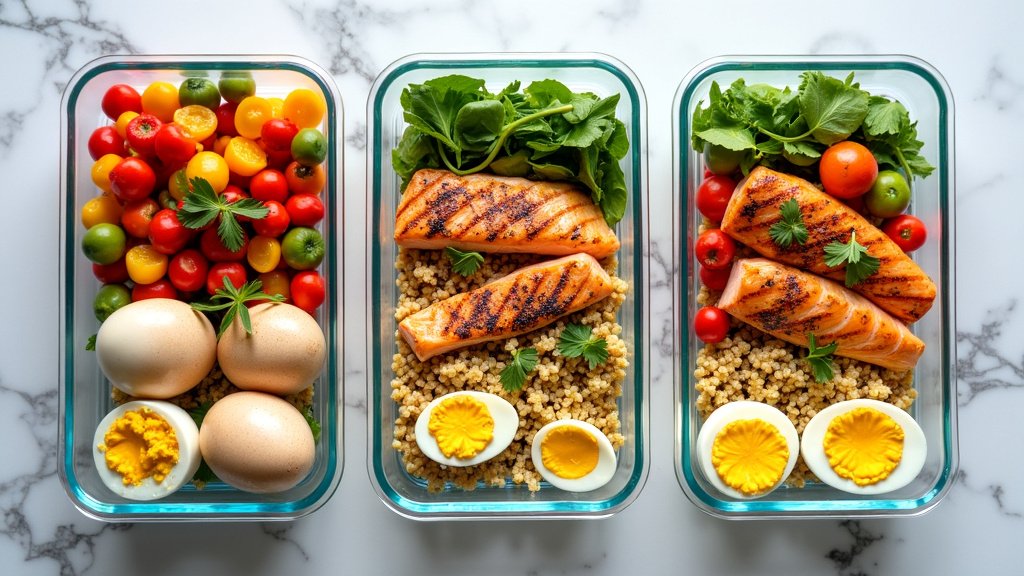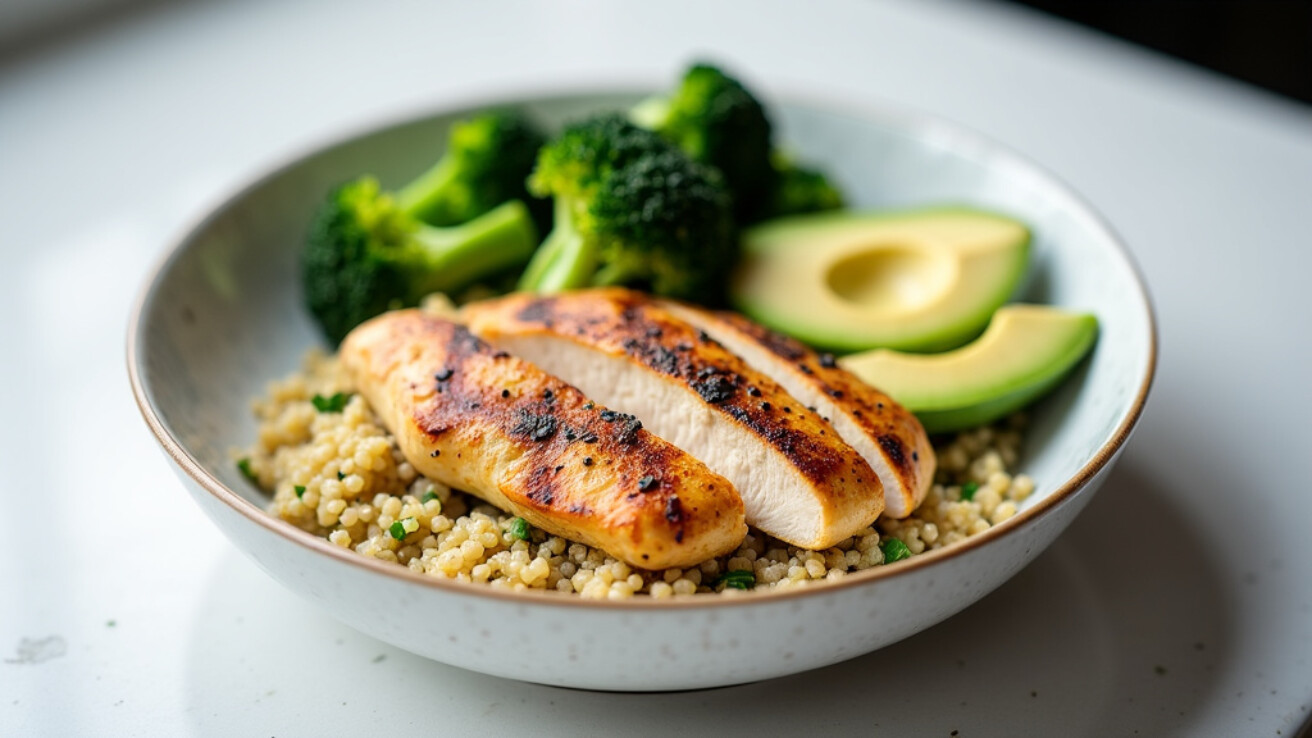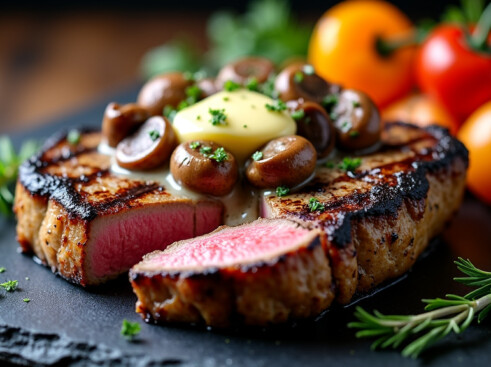Tired of diets that leave you feeling drained and hungry? A well-structured protein diet plan could be exactly what you need. As someone who’s analyzed countless nutrition studies and meal plans, I’ve found that high-protein diets are game-changers for sustainable weight loss.
Research from the Journal of Obesity & Metabolic Syndrome shows that protein helps you feel fuller longer than carbohydrates, particularly when compared to refined white flour foods. This natural appetite control makes it easier to eat less and lose weight without feeling deprived.
Whether you’re looking to drop 10 pounds or transform your body, this comprehensive 7-day protein diet plan will show you how to harness protein’s fat-burning potential while preserving muscle mass. You’ll discover simple meal ideas that deliver 1.2-2 grams of protein per kilogram of body weight – the sweet spot for weight loss according to nutrition experts.
Over the next week, I’ll guide you through delicious high-protein breakfast options, satisfying lunches that prevent afternoon cravings, and dinners that fuel muscle recovery overnight. Plus, you’ll get practical tips for meal prep, smart snacking, and staying on track even during busy weeks.
Best of all, this isn’t a restrictive diet that eliminates entire food groups. You’ll learn how to create balanced meals using lean proteins, healthy fats, and strategic carbohydrates that work together to promote fat loss while maintaining your energy and vitality.
Understanding the Power of Protein for Weight Loss

Protein emerges as your body’s most powerful ally in weight loss. Research consistently shows that increasing protein intake transforms how your body manages weight loss through multiple mechanisms.
The most significant benefit of protein is its remarkable ability to keep you feeling full longer. Studies reveal that protein provides up to three times more satiety than equal calories from carbohydrates or fats, naturally reducing your daily food intake.
Your body expends more energy processing protein compared to other nutrients. Clinical evidence shows that 20-30% of protein’s calories are burned through digestion alone, compared to just 5-10% for carbs and 0-3% for fats.
The Science Behind Protein’s Fat-Fighting Power
High-protein diets trigger the release of key satiety hormones like GLP-1, CCK, and PYY, which signal your brain that you’re full. Simultaneously, they reduce levels of ghrelin, known as the ‘hunger hormone.’
Research demonstrates that consuming more protein significantly boosts metabolism. One study found that subjects on a high-protein diet burned nearly 900 more calories daily compared to those eating standard amounts of protein.
Crucially, protein helps preserve lean muscle mass during weight loss. A comprehensive analysis showed that higher protein intake (around 25-30% of calories) resulted in greater fat loss while protecting metabolism-boosting muscle tissue.
Why Protein Beats Traditional Low-Fat Diets
Traditional low-fat diets often lead to loss of muscle mass alongside fat, ultimately slowing metabolism. In contrast, studies show high-protein diets specifically target fat while preserving lean tissue.
Clinical trials demonstrate that people following high-protein diets (30% of calories) lose more body fat compared to those on conventional low-fat diets. They also report greater satisfaction and reduced hunger.
For sustainable weight management, research indicates consuming 1.2-1.6 grams of protein per kilogram of body weight daily provides optimal benefits for fat loss and satiety. This typically translates to 25-30% of total daily calories from protein.
Calculating Your Protein Needs for Optimal Weight Loss
Protein plays a crucial role in preserving muscle while burning fat during weight loss. Research and experience show that many people underestimate their protein needs during this process.
Research has shown that when reducing calories, up to 25% of weight loss can come from muscle tissue unless adequate protein intake is maintained. This makes calculating your personal protein requirements essential.
Calculating Your Base Protein Needs
For healthy adults aiming to lose weight while preserving muscle, target 1.8 to 2.7 grams of protein per kilogram of body weight daily (approximately 0.8-1.2 grams per pound).
For example, if you weigh 180 pounds, your target protein intake would range from 144 to 216 grams per day. This serves as a starting point that can be refined based on your specific situation.
If you’re carrying extra body fat, adjust these numbers down slightly since protein needs are primarily based on lean mass. In this case, calculate using your goal weight instead of current weight.
| Activity Level | Protein Intake (g/kg) |
|---|---|
| Sedentary | 0.8-1.0 |
| Moderate Activity | 1.3 |
| Heavy Strength Training | 1.4-2.0 |
| Optimal Range for Weight Loss | 1.2-2.7 |
Adjusting for Activity Level
Your exercise routine significantly influences optimal protein intake. Regular strength training increases your body’s protein demands for muscle recovery and preservation.
According to research published in the British Journal of Sports Medicine, active individuals may need up to 2.2 grams of protein per kilogram of body weight to maximize muscle retention during weight loss.
If you’re new to exercise, start at the lower end of the range and adjust upward as your training intensity increases. The key is consistency in both your workouts and protein intake.
Timing Your Protein Intake
While total daily protein matters most, spreading your intake throughout the day helps maximize its benefits for muscle preservation. Aim to consume protein at regular intervals.
Research suggests consuming 20-40 grams of protein per meal provides optimal muscle-preserving benefits. This means including a quality protein source at each meal and potentially adding protein-rich snacks.
For most people, this translates to 3-4 main meals containing protein, plus 1-2 protein-rich snacks depending on your total daily target.
Remember that these guidelines are starting points. You may need to adjust your intake based on how your body responds and your specific weight loss goals.
7-Day High-Protein Meal Plan for Effective Weight Loss

A well-structured high-protein meal plan effectively supports weight loss by preserving muscle mass while promoting fat loss. Research demonstrates that consuming 25-35% of calories from protein leads to greater weight loss compared to standard protein diets of 12-18%.
On this plan, you’ll consume approximately 1.2-2.0 grams of protein per kilogram of body weight daily. This increased protein intake helps control appetite, enhance metabolism, and maintain lean muscle during calorie restriction.
Daily Meal Structure
The plan provides 3 main meals and 2 protein-rich snacks daily, totaling 1,500-1,800 calories based on individual needs. Each main meal delivers 25-30g protein, while snacks provide 10-15g protein.
A typical day features lean proteins such as chicken breast (25g protein per 3oz), fish (22g protein per 3oz), eggs (6g protein each), and protein-rich plant foods like lentils and quinoa. The plan incorporates abundant vegetables and measured portions of whole grains.
| Day | Meal | Items | Calories | Protein (g) | Carbohydrates (g) | Fat (g) |
|---|---|---|---|---|---|---|
| Day 1 | Breakfast | Grapefruit, Poached Eggs, Whole Wheat Toast | 327 | 18 | 41 | 11 |
| Day 1 | Snack | Banana, Plain Yogurt with Honey | 324 | 14 | 62 | 4 |
| Day 1 | Lunch | Grilled Chicken Breast, Garden Salad | 396 | 41 | 18 | 18 |
| Day 1 | Snack | Baby Carrots, Hummus, Pita Bread | 192 | 7 | 31 | 5 |
| Day 1 | Dinner | Steamed Broccoli, Brown Rice, Halibut | 399 | 34 | 57 | 4 |
| Day 1 | Snack | Medjool Dates, Dark Chocolate | 302 | 3 | 49 | 12 |
Meal Prep Tips for Success
Batch cooking proteins such as chicken breasts, hard-boiled eggs, and roasted fish saves valuable time. Store prepared proteins in portioned containers for efficient meal assembly throughout the week.
Keep protein-rich snacks easily accessible – pre-portion Greek yogurt cups, prepare bags of almonds and seeds, or store protein bars for busy days. This strategy helps avoid less nutritious choices when hunger strikes.
Making Substitutions
For plant-based diets, replace animal proteins with tempeh, tofu, seitan, or legumes. Those avoiding dairy can maintain adequate protein intake using dairy-free protein powders and plant-based yogurt alternatives.
Maintain consistency with this meal plan while adapting portions and food choices to suit your preferences and needs. The emphasis remains on sufficient protein, controlled calories, and nutrient-dense whole foods to support your weight loss goals.
Best Protein Sources for Your Weight Loss Journey
Looking to shed those extra pounds? Protein is one of the most effective tools for weight loss success.
A well-structured high-protein diet preserves lean muscle mass during weight loss and increases satiety between meals. The key is selecting proteins that provide maximum nutrition with minimal calories.
Here are the most effective protein sources to help you reach your weight goals while maintaining optimal health.
Lean Animal Proteins: Your Weight Loss Allies
Chicken breast leads the pack when it comes to lean protein, providing 26.7 grams of protein per half breast. It’s rich in B vitamins, zinc, and selenium to support your metabolism.
Turkey breast delivers similar benefits with 25.6 grams of protein per 3-ounce serving. Its low-fat profile makes it ideal for calorie-conscious eating.
Fish deserves special attention in your weight loss plan. A cod fillet provides 41 grams of protein, while fatty fish like salmon adds heart-healthy omega-3 fats.
Plant-Based Protein Powerhouses
Lentils excel as a vegetarian protein source with 9 grams per half cup, plus fiber for hunger control. Research links regular legume consumption to reduced heart disease risk.
Quinoa provides 8 grams of protein per cup and contains all nine essential amino acids. This versatile grain serves as an excellent base for protein-rich meals.
Black beans offer nearly 9 grams of protein per 100g serving and contain fiber that helps regulate blood sugar levels and increase satiety.
Dairy Proteins for Weight Management
Greek yogurt contains 20 grams of protein per 7-ounce serving. It’s rich in calcium and probiotics, supporting bone health and digestion.
Cottage cheese provides 28 grams of protein per cup, making it one of the most protein-dense dairy options. It works well in both sweet and savory high-protein snacks.
Low-fat milk delivers 8.3 grams of protein per cup along with calcium and vitamin D. It’s effective for post-workout recovery.
Smart Protein Snacking Options
Eggs contain 6.3 grams of protein each and all essential amino acids. They’re versatile and ideal for meal preparation.
Almonds provide 6 grams of protein per ounce along with healthy fats and fiber. They’re perfect for portable snacking.
Pumpkin seeds contain 8.8 grams of protein per quarter cup and essential minerals like iron and magnesium. They complement salads and yogurt bowls perfectly.
| Protein Source | Protein Content (g) | Additional Nutrients |
|---|---|---|
| Chicken Breast | 26.7 per half breast | B vitamins, zinc, selenium |
| Turkey Breast | 25.6 per 3 oz | Low-fat |
| Cod Fillet | 41 per fillet | Low-fat, omega-3 |
| Lentils | 9 per half cup | Fiber |
| Quinoa | 8 per cup | All nine essential amino acids |
| Black Beans | 9 per 100g | Fiber |
| Greek Yogurt | 20 per 7 oz | Calcium, probiotics |
| Cottage Cheese | 28 per cup | Calcium |
| Low-fat Milk | 8.3 per cup | Calcium, vitamin D |
| Eggs | 6.3 each | Complete amino acids |
| Almonds | 6 per ounce | Healthy fats, fiber |
| Pumpkin Seeds | 8.8 per quarter cup | Iron, magnesium |
Combining Protein with Exercise for Enhanced Weight Loss
Following a high-protein diet combined with strategic exercise creates a powerful weight loss strategy. When you pair adequate protein intake with regular workouts, you maximize fat burning while preserving valuable muscle mass.
Studies have shown that consuming between 1.2-2g of protein per kilogram of body weight while exercising helps prevent muscle loss during weight reduction. This translates to approximately 82-136g daily for a 150-pound person seeking optimal results.
Resistance training plays an essential role when following a high-protein diet. Research indicates that strength training 2-3 times per week helps maintain lean muscle, keeping your metabolism elevated during weight loss. Focus on compound exercises like squats, deadlifts, and bench presses that engage multiple muscle groups.
Optimizing Your Workout Routine
To maximize benefits, alternate between strength training days and moderate cardio sessions. This approach allows your muscles time to recover while maintaining calorie burn through aerobic activity. Aim for 30-45 minutes of cardio 3-4 times weekly.
Timing your protein intake around workouts can enhance results. Consume 20-30g of protein within 2 hours after exercise when your muscles are primed for nutrient absorption and rebuilding. High-quality sources like lean meats, fish, eggs, and protein powders work well.
For enhanced fat burning, incorporate high-intensity interval training (HIIT) 1-2 times per week. Short bursts of intense exercise followed by brief recovery periods boost metabolism and fat oxidation when combined with adequate protein intake.
Finding the Right Balance
Listen to your body as you increase both protein and exercise. Start slowly if you’re new to working out, gradually building intensity and duration. Proper form is crucial for preventing injury and achieving optimal results.
Stay hydrated and ensure you’re eating enough total calories to fuel your workouts. Even in a calorie deficit, you need sufficient energy to exercise effectively. Aim for a moderate deficit of 20-25% below maintenance.
Get adequate rest between training sessions to allow for recovery and muscle repair. Quality sleep is essential when combining a high-protein diet with regular exercise. Most people need 7-9 hours nightly for best results.
Overcoming Challenges on Your High-Protein Diet
Transitioning to a high-protein diet can seem daunting at first. While the benefits are well-documented, from improved muscle maintenance to better appetite control, you may encounter some hurdles along the way. Here are practical solutions to help you succeed.
Managing Digestive Adjustments
One of the most frequent challenges when increasing protein intake is digestive discomfort. Your body needs time to adapt to processing more protein, which can initially lead to bloating, gas, or constipation.
The key is to gradually increase your protein intake while ensuring adequate hydration. Research indicates that high-protein diets require more water to help your kidneys process the additional protein efficiently.
Adding fiber-rich foods and probiotics to your diet can help maintain digestive balance. Consider incorporating foods like yogurt, leafy greens, and legumes to support healthy digestion while meeting your protein goals.
Preventing Meal Monotony
As Jamie Nadeau, RD of The Balanced Nutritionist, suggests, Take advantage of quick, low-prep protein sources like Greek yogurt, cottage cheese, canned tuna or canned chicken, frozen edamame, store-bought rotisserie chicken, and eggs
. This variety helps prevent diet fatigue.
Try rotating between different protein sources throughout the week. For instance, alternate between lean meats, fish, dairy, and plant-based options like quinoa and legumes.
Experiment with various cooking methods and seasonings to keep meals interesting. Grilling, baking, or stir-frying can transform the same protein source into distinctly different dishes.
Meeting Daily Protein Goals
According to current dietary guidelines, protein should represent 10-35% of your daily calories. For the average healthy adult, this translates to 0.8-1.0 grams per kilogram of body weight daily.
Break down your protein intake into smaller, manageable portions throughout the day rather than consuming large amounts in one sitting. This approach enhances absorption and digestion.
Keep convenient protein sources readily available for snacking. Options like cottage cheese, hardboiled eggs, or Greek yogurt can help you meet your goals between meals.
| Food | Protein (g per 100g) | Protein (% of total energy) |
|---|---|---|
| Egg | 12.3 | 36.7% |
| Avocado | 1.6 | 4.2% |
| Banana | 1.1 | 4.7% |
| Chicken Breast | 21.5 | 58.6% |
| Cottage Cheese | 13.6 | 72% |
| Skyr | 11 | 63% |
Maintaining Proper Balance
While focusing on protein is important, remember that a well-rounded diet is essential. Some high-protein diets can be restrictive in terms of carbohydrates, potentially leading to nutritional imbalances.
Include a variety of colorful vegetables with your protein sources to ensure you’re getting adequate fiber and micronutrients. This combination supports both your protein goals and overall health.
Watch for signs that you might need to adjust your approach, such as excessive fatigue or persistent digestive issues. These could indicate a need to modify your protein sources or adjust your macro balance.
Achieve Your Weight Loss Goals with Protein
A well-structured high-protein diet is more than just a trend—it’s a scientifically backed approach to sustainable weight loss. By increasing your protein intake, you’ll naturally curb hunger, boost your metabolism, and preserve lean muscle while shedding fat. Research consistently proves that protein helps you lose weight without feeling deprived, making it an effective strategy for long-term success.
With the 7-day meal plan and practical tips provided, you now have the tools to optimize your diet and reach your goals efficiently. Whether you’re aiming for a small transformation or a major weight loss journey, prioritizing protein will keep you energized, satisfied, and on track. Pair this plan with regular exercise and mindful eating habits, and you’ll unlock your body’s full fat-burning potential.
Now, it’s time to take action—start your high-protein journey today and experience the difference for yourself!






